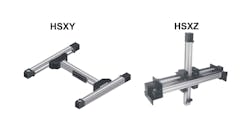Industrial robot systems offer everything a modern manufacturer can hope for, from running 24/7 to improve productivity to relieving humans from repetitive, sometimes injury-inducing manual labor.
Sometimes, though, the wiser choice for your smart factory could be to keep it simple. Six-axis robots can do nearly anything, from pouring beers to defending your plant from ninjas, but the total cost could reach up to $150,000 after installation and integration when is all said and done.
Maybe all you need to do is clamp workpieces or run a pick-&-place operation. In these cases, 2-axis electric belt-driven actuators, the HSXY and HSXZ, could perform the job you need at 50 to 75% of the cost compared to a robot, based on length, control systems, and similar variables, says Gilbert Guajardo, a Bimba Manufacturing Co. product manager.
“The HSXY and HSXZ can solve many of those applications when a large six-axis robot is overkill,” he says of the products, launched in July 2015 and appeared at the Industrial Manufacturing Trade Show in Chicago.
Take a look at this linear robot in action:
Much of the power that makes these a reasonable alternative to robots is the steel woven polyurethane, serpentine belt configuration, which loops around both axes, allowing both servo motors to be placed on the X-axis.
This is where the smarts come in: a controller can coordinate these motors to work in harmony, doubling the torque. If each motor in the x-axis has a torque of 100 in/lb, then together they provide 200 in/lb in the Z-axis, Guajardo explains.
Most intelligent motion controllers capable of coordinated motion can achieve this function, he says.
Bimba calls them linear robots for their power and versatility, and they fall under Bimba’s IntelliAxis brand. The horizontal-moving HSXY, or H-Bot, can be used for diverting or insertion applications, as well as sorting, clamping, and holding.
The HSXZ, or T-Bot, moves up and down, is best suited for pick-&-place duties, and would also work for loading applications and conveyor transfer.
“They’re fast, robust, and have a large load-carrying capability,” says Guajardo, noting that the aluminum extrusion material is 25% stronger than competitors.
Both HSXY and HSXZ will demonstrate motion profile speeds of 75, 150, and 300 in/sec speeds at IMTS.
By reducing axes, you can also reduce the size, and these actuators take up a lot less real estate. The currently available profiles are 3.1 x 3.1 in. (80 x 80 mm) for the T-Bot, and 0.6 x 0.6 in. (15 x 15 mm) model for the H-Bot.
If your application still requires a six-axis robot, these actuators could still be of use as a 7th axis.
Other features include self-lubricating square rail ball bearings, low noise vibration, direct mounted planetary gear reducers, and multiple carriage options, as well as carriage lengths.
About the Author
John Hitch
Editor, Fleet Maintenance
John Hitch, based out of Cleveland, Ohio, is the editor of Fleet Maintenance, a B2B magazine that addresses the service needs for all commercial vehicle makes and models (Classes 1-8), ranging from shop management strategies to the latest tools to enhance uptime.
He previously wrote about equipment and fleet operations and management for FleetOwner, and prior to that, manufacturing and advanced technology for IndustryWeek and New Equipment Digest. He is an award-winning journalist and former sonar technician aboard a nuclear-powered submarine where he served honorably aboard the fast-attack submarine USS Oklahoma City (SSN-723).

